3,000 Steps with Brian Bolwell, MD
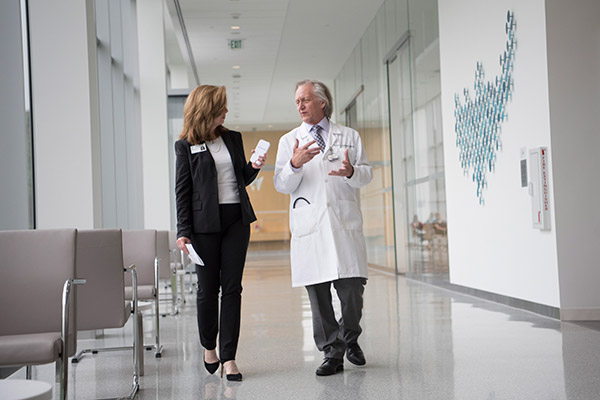
By Jill Stefancin
Even though it’s a cloudy day in Cleveland, the lobby of Cleveland Clinic’s Cancer Center is infused with daylight, its sleek modern furnishings complementing the mostly glass-enclosed first-floor lobby.
Brian Bolwell, MD, Chair of the Taussig Cancer Institute, meets me there, ready to walk and talk about what makes Cleveland Clinic's Cancer Center unique, his role as head of one of the nation’s top cancer centers and how funding from VeloSano impacts cancer research. The sixth year of “Bike to cure,” VeloSano’s flagship event where 1OO% supports lifesaving cancer research at Cleveland Clinic, takes place in Cleveland July 19-21.
Q. The Taussig Cancer Center opened nearly two and a half years ago. You were so involved in the planning and design of the building – did it turn out the way you’d anticipated?
A. Yes, we’re very proud of it. When we looked at some other cancer centers, we were struck by how dark they were. We really wanted light to be a big deal in this building. And it is – light traverses the entire building on every floor from the south to the north. We also really wanted our infusion suites, which are right above us on floors 2, 3 and 4, to look out on the mall, and they do and that’s very nice. There was a fair amount of thought on how to plant the trees and the shrubs out there.
The other thing we wanted the building to do is provide multidisciplinary care. For example, our breast cancer program consists not just of people who work in Taussig, but surgeons and other people who work in other institutes. We’re kind of the model for showing cross-institute collaboration in clinical care as well as in research and education. And so by having our floors segregated into disease-based floors, we promote programmatic growth.
So from that perspective, the way we’ve organized the clinical floors is very important. I mean, even the entryway is something we’re really proud of.
Q. Why? What’s special about the building’s entry?
A. When we were working with our architectural firm, I asked the two primary architects to stand in the lobby of our prior location for an hour and just watch. It was obvious that patient pick-up and drop-off was a challenge. Here, the pick-up and drop-off area is longer than a football field – it’s enormous. And the building is cantilevered so we have this broad overhang that’s supported by nothing. Even if it takes you 10 minutes to get out of your car, there’s no rush. You’re covered from snow or rain or whatever, and there are no support beams to get in your way. There’s so much steel in the building that all of the weight of the building goes from the south side of the building, all the way up to the middle and is distributed there. A lot of thought went into making this as good as we can for our patients.
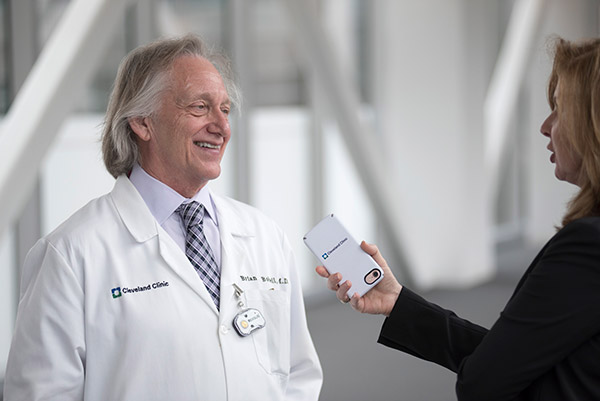
Q. What’s the connection between the people who are riding in VeloSano and what happens inside this building?
A. All the money, the research dollars are used in a lot of different ways. Much of the support goes to LRI [Lerner Research Institute], where they’re doing all sorts of cool projects. Some of the dollars go to clinical research, which is done here in this building. The main thing is that there’s not a division between clinical care and research. Basically, everything we do is a quest to make things better.
One thing that attracts patients to our cancer center is our clinical trials. We have hundreds of clinical trials that allow our patients to get the latest drugs, the most promising drugs and the most promising ways to treat their cancer. VeloSano is a catalyst to all of that.
Q. Thinking back to VeloSano’s first year, did you ever imagine it would become such a big thing and generate the kind of funding that it has?
A. No, I’ve been pleasantly surprised. I had no idea that VeloSano could do what it does. Up until then, this group of motivated and committed individuals was unknown to Cleveland Clinic. I’ve learned that the “bicycling community” is a very motivated, close-knit community and the donors who support the cause also are a very motivated and committed group of people. Those groups and the wonderful team who help make the event a reality are really the ones who make it successful. It’s just a wonderful achievement. The Friday night kickoff party before the ride is a big deal, and I try to illustrate to to the crowd the impact that they're making.
Q. What goes through your mind when you’re on the stage the night before the ride, looking out at the sea of people who are giving their all for cancer research?
A. Well, I ‘m very thankful, that’s the primary emotion. All these people are giving their time and their effort to do what they can to increase our ability to treat this disease and make it go away. I’m just very, very grateful for all of that. I’m also very empathetic because I know that a number of people in the audience at the event have cancer and are actively going through their journey. Those are the people I try to address more than anybody.
Q. What would you say to people who are thinking about supporting VeloSano but haven’t yet made the commitment?
A. It’s fun, and even if you don’t bike you can still be a huge part of VeloSano. If you want to pseudo-bike, we have spinning on the day of the event on the mall. But it’s just fun. It’s a very inspirational event, it’s a very emotional event, it’s unlike anything you’ve ever done, especially again the night before. The night before is definitely worth attending. It’s a celebration, there’s a lot of energy at that event; it’s kind of palpable in the air. But the main thing is it’s an experience that is worthwhile, enjoyable and fun. I would highly recommend it.
I think everybody knows someone who’s had cancer, and the importance of raising money for research should be fairly straightforward. The cool thing about VeloSano is that if you participate in it, you become part of a community, you become part of a group of people who are wonderful – wonderful to get to know and wonderful to be around. That’s the huge secondary gain to becoming part of the VeloSano movement.
How You Can Help
It’s not too late to join the VeloSano community and get involved! Ride, donate, volunteer or ring some cowbell during the "Bike to cure" this weekend, July 19-21.
Latin for “swift cure”, VeloSano is a year-round, community-driven fundraising initiative to support lifesaving cancer research at Cleveland Clinic. Since the inaugural ride in 2014, more than $17 million has been raised, and 1OO% of those funds are hard at work in the fight against cancer.
From Lab to Bedside: New Center Hopes to Hasten the Journey
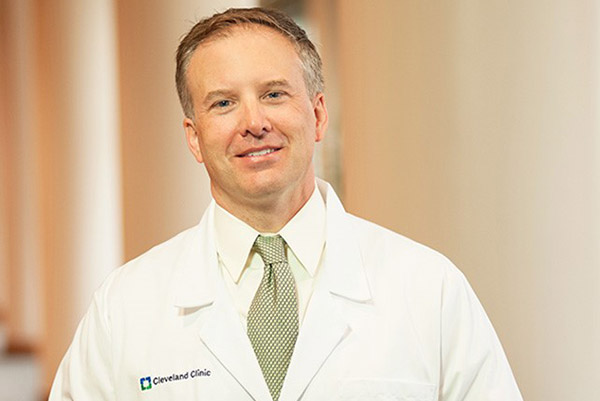
By Mary Mihaly
When it comes to creating new therapeutic drugs, it’s a long road from the test tube to patient treatment. Two of the biggest barriers are time and money: It can cost up to $1 billion and take nearly 10 years to bring a new medication to market.
The new Cleveland Clinic Center for Therapeutics Discovery, located within the Lerner Research Institute, aims to shorten this road.
“To get there, we need to understand the gaps in patient care, identify innovative approaches that address those gaps, and then work diligently in the lab to validate and de-risk those hypotheses before testing in patients,” says Shaun Stauffer, PhD, Director of the Center for Therapeutics Discovery. Many coordinated disciplines and tools are required to reach a promising therapeutic for clinical testing. Dr. Stauffer’s mission is to surround each project team with talented individuals who can steer investigators along a path that avoids the so-called “valley of death.”
Drugs work by binding to a target in a cell, usually a protein, Dr. Stauffer explains. The challenge for him and his team is matching the right compound to the right target protein. If they can make that match and show that the agent is effective and selective, they’re on their way to discovering a new drug treatment.
Understanding a Drug’s ADME
A key element, Dr. Stauffer says, is understanding early a set of parameters called ADME—absorption, distribution, metabolism and elimination of the new compound. “It’s critical for us to understand how the drug distributes throughout the body, then how it’s metabolized and if the metabolites have activity of their own,” he explains.
“It’s rare that research institutions invest in the infrastructure to answer these questions,” he adds, which points to the vision of Cleveland Clinic and the opportunity before the Center for Therapeutics Discovery.
Reducing Timelines, Finding Cures
“The patient-caregiver relationship at Cleveland Clinic and the eye toward translational medicine at the Lerner Research Institute gives us an advantage to accelerate the most promising ideas to reach the center’s ultimate goal, cures for diseases,” Dr. Stauffer says.
“We’re going after the low- and the high-hanging fruit —Alzheimer’s, Parkinson’s, various cancers. By proactively validating novel targets and identifying early tools and drug candidates, we will reduce the timeline and cost of finding cures for those diseases, and, in some instances, we already can see the finish line,” he says.
“The time is perfect for major hospitals to achieve drug discovery. All we need is a vision, the right teams and philanthropic support.”
How You Can Help
As a nonprofit healthcare organization, Cleveland Clinic counts on philanthropic support to help us conduct lifesaving research like Dr. Stauffer’s.
Grant-funded Cancer Support Group Provides a Shoulder to Lean On
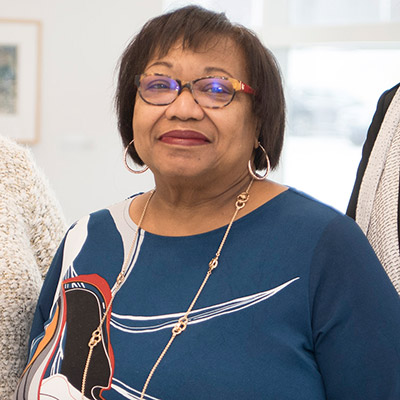
A room brimming with love and encouragement is capable of inspiring anyone passing through. At a recent meeting of the Cancer Survivors Support Group at Cleveland Clinic’s Stephanie Tubbs Jones Health Center, smiles and laughter became contagious, as members shared stories and experiences with one another, appreciating each joy-filled moment, no matter how small.
The group, formed years ago, was able to expand earlier this year after receiving a Caregiver Catalyst Grant from the generosity of thousands of donors.
Grant Program Combines Gifts to Support Caregiver Ideas
The Caregiver Catalyst Grant program is a unique way for Cleveland Clinic to reward its employees, referred to as caregivers, for innovative thinking and initiative. The grants pool thousands of donations into a fund that is allocated to bright ideas submitted by hundreds of caregivers. Because funds are limited, not every idea can be rewarded, making the program highly competitive.
In its first round, the Caregiver Catalyst Grant program had 153 applicants, of whom 29 received grants. Gayle B. Ivory, LSW, was one of these few chosen to receive a Caregiver Catalyst Grant. Her idea: expand the cancer support group in the East Cleveland community and allow for trips to area attractions and overnight retreats for its members.
Idea Addresses Community Need
Ms. Ivory is a social worker at the Stephanie Tubbs Jones Health Center. Her inspiration for creating the Cancer Survivors Support Group came from personal experiences with family members who had been diagnosed. “Knowing what our family went through, I knew there was a need to support patients and families,” Ms. Ivory says.
She was ecstatic when she received word that her idea had been chosen for a Caregiver Catalyst Grant and that she would receive the $10,000 requested in her submission. “The whole Center celebrated with me. Other caregivers working at the Center know these women in the support group, so the caregivers were excited that we’d have the money to do additional support activities with them.”
Currently, nine members meet on the third Wednesday of each month. They participate in a range of activities from discussing topics of interest and listening to one another’s thoughts and concerns, to hosting special guests to guide in music therapy, art therapy and nutrition education.
Continued Support Places Focus on Cherishing Life
“This is so helpful to the cancer survivors,” Ms. Ivory says. “Many of our members have had cancer come back, and the group gives an opportunity to talk to others who have experienced the same thing. It serves as another outlet for the members as they go through their cancer experience.”
During one of the music therapy sessions, the group members came up with their own song. “We call it ‘Lean on Me,’” she says. “A support for everyone in the group. It says what we do – we lean on each other, support each other, help each other.”
Birthday celebrations also hold strong significance to the members because of the importance of recognizing, celebrating and cherishing one more year of life.
Ms. Ivory’s group places a strong focus on continued support not only during cancer treatments, but also long after treatments end. It is about support throughout the entirety of the cancer journey, including as a survivor. Because of this, there has been a family dynamic established between the women.
“This cancer group is unique,” says one of the members. “Before I found this group, I had been to a lot of others, but I always found I was more depressed. This group brought me back to life. It shows us we can still live even though we are going through what we’re going through.”
Philanthropy Helps Group Celebrate Courage
The women who participate find strength in the ability to direct their time and energy toward the importance of living their best lives rather than talking about the possibility of dying. As another woman says, “This group gives you something to fight for.”
During the June 2019 meeting, one woman passed around a “certificate of bravery” that her granddaughter had made for her. Shortly after, another member announced her newest victory by saying, “I’m going to be a third-time survivor.” Everyone in the room celebrated the courage and strength of both women.
Although the group would still be meeting without the Caregiver Catalyst Grant, many additional activities would not have been possible. For example, the group goes on outings, such as a recent overnight retreat to Geneva on the Lake, a trip on the Cuyahoga Valley Scenic Railroad, a ride on the Nautica ship on Lake Erie, and a visit to the Cleveland Aquarium. Ivory notes that none of these outings would be possible for the members if they had to cover their own expenses.
“Philanthropy gives me a warm feeling knowing it’s the support to allow me to help this group,” Ms. Ivory says. “We are helping these people.”
How You Can Help
Your gift to the Caregiver Catalyst Grants helps caregivers like Gayle implement their best and brightest ideas and positively impact our patients and communities.
Family Foundation Helps Students Become Nurses
LaShariah Williams and Breyana Burgos knew when they were kids that they wanted to become nurses. Thanks to Cleveland Clinic’s ASPIRE Nurse Scholars Program, both are well on their way to achieving their childhood dreams.
Philanthropically supported by the Howley Foundation, the program is designed to create career paths for underserved students to become nurses at Cleveland Clinic.
Nick Howley, Executive Chairman of TransDigm Group, Inc. and a member of Cleveland Clinic’s Board of Trustees, came up with the idea while a patient at Cleveland Clinic. During recovery after an orthopaedic procedure, he asked his nurses about their education and how they came to work at the hospital.
Nick and his wife, Lorie, who are passionate about underserved individuals having access to education, wanted to make it easier for those interested in nursing to afford to go to college. They took the idea of funding a career path program to Executive Chief Nursing Officer Kelly Hancock, DNP, RN, who put it into motion. Dr. Hancock holds the Stanley Shalom Zielony Endowed Chair for Nursing Advancement.
In July 2016, Daria Sheafe, MSN, RN, a home care triage nurse and primary care coordinator at Cleveland Clinic, was hired to coordinate ASPIRE. Cuyahoga Community College (Tri-C) came on as the academic partner for the program.
Open to high school juniors in Northeast Ohio who maintain a 3.0 or higher grade point average, ASPIRE was a hit from the beginning. Seventy-seven juniors applied for the 25 available spots in the first session, which took place on 12 consecutive Saturdays in early 2017. “In 2018, we received 174 applications from 38 schools for the same 25 openings,” Daria says.
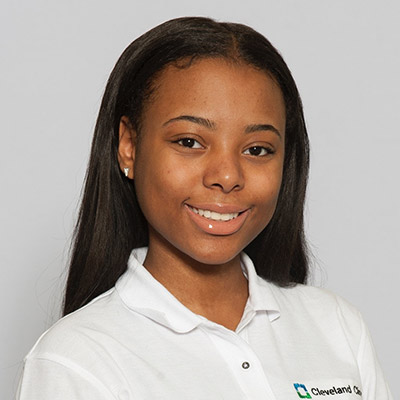
ASPIRE student LaShariah Williams
LaShariah was one of the members of the inaugural session, learning introductory nursing skills that included hands-on training in the simulation lab at the Stanley Shalom Zielony Institute for Nursing, as well as guidance in professional development.
As a senior, LaShariah and 18 other members from the original session returned to ASPIRE to serve as mentors to the second class. LaShariah, now in her second semester at Tri-C, made the dean’s list her first semester.
“It was a great opportunity,” she says of ASPIRE. “You learn a lot, and you find yourself with this program.”
Breyana, also a nursing student at Tri-C, agrees. “The ASPIRE Nurse Scholars program is very amazing. It just feels so good knowing that the program has had my back and has had its hand in helping me create my future.”
Along with their schooling, Breyana and LaShariah have been working for nearly a year as patient care nursing assistants on Cleveland Clinic’s main campus.
How You Can Help
For information about the ASPIRE program and how your gift can help underserved high school students start on a career path to become nurses, please contact Amanda Hollis by email at hollisa2@ccf.org.

